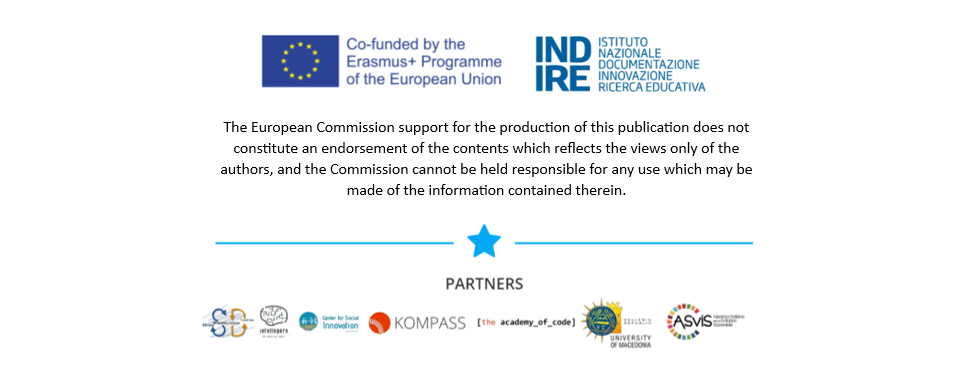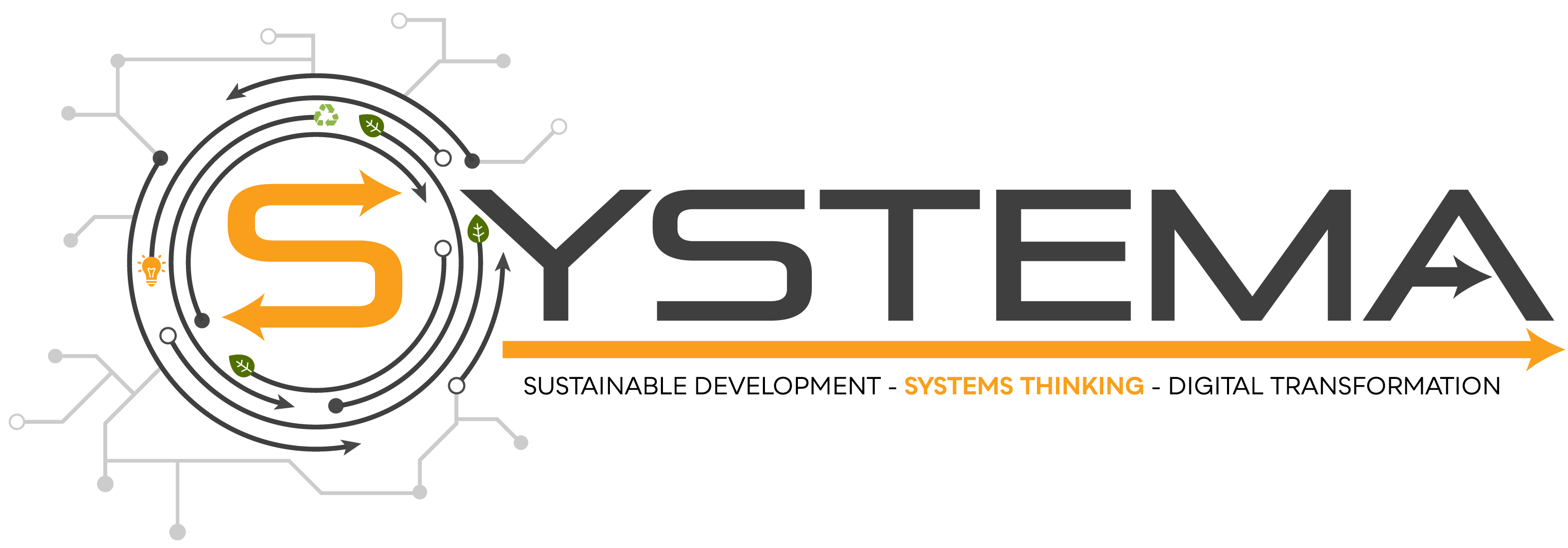1. Introduction
This article aims to highlight the importance of systems thinking in supporting organisations towards their sustainable transformation. It is written as part of the SYSTEMA EU project, which offers a freely accessible online educational platform on systems thinking and its significance for decision-makers seeking to achieve sustainable development and digital transformation within any context.
Sustainability is a crucial aspect of our global system that encompasses environmental, social and economic considerations1. “It involves meeting the present needs without compromising the ability of future generations to meet their own2.” For businesses, sustainable development is essential for long-term success. Embracing sustainability can enable organizations to create positive impact on the environment, society, and economy leading to enhanced reputation, increased customer base, and improved employee motivation and satisfaction. Moreover, it can help businesses identify new opportunities for innovation while mitigating risks associated with regulatory changes and resource depletion3.
Figure 1: The Triple Bottom Line of Sustainability
Image taken from: https://waste4change.com/blog/the-triple-bottom-line-of-sustainability-in-waste-management/
2. Understanding Systems Thinking
One effective approach to achieve sustainable development is systems thinking, which has been identified as one of the 12 core sustainability competences4. Systems thinking is a holistic approach that helps organizations understand the complex interactions and relationships between different components within a system5. By analysing the system as whole, business can identify leverage points for positive change and create more effective, sustainable solutions6. An example of system thinking application is the popular concept of circular economy, which is closely linked to sustainability7.
Figure 2: GreenComp Sustainability Competences
Image taken from https://joint-research-centre.ec.europa.eu/greencomp-european-sustainability-competence-framework/greencomp-conceptual-reference-model_en
3. Systems Thinking for startups
Startups, established companies, and small-medium sized enterprises (SMEs) can all benefit from applying systems thinking to drive sustainable development. Startups have the advantage of being able to build their business practices from scratch and incorporate sustainability from the outset. By using systems thinking, startups can identify key components of their system, such as supply chains, productions processes, and distribution networks, and analyse the relationships and interactions between them to create more sustainable and efficient systems. In addition, systems thinking can help startups explore opportunities for innovation, particularly within their value chain and gain a competitive advantage.
4. Systems Thinking for established companies
On the other hand, established companies can benefit from systems thinking by using it to transform their existing systems into more sustainable ones. For example, Toyota, a leading automotive company, has implemented a production system that focuses on reducing waste and optimising efficiency. By looking at the entire production system and understanding how each component interacts, Toyota has been able to create a more sustainable production system, known as “The Toyota Way” . Since then, Toyota has become a reference point and inspiration for other companies that have followed its efficient production process. Similarly, other companies like Nike have used systems thinking to create more sustainable supply chains by identifying and addressing the environmental impacts of their operations9.
5. Systems Thinking for SMEs
SMEs often face unique challenges when it comes to sustainability, as they may not have the resources or capacity to implement large-scale sustainability initiatives. However, by adopting systems thinking, SMEs can identify areas where they can make a significant impact with minimal resources. By understanding how their resource recovery systems operate and promoting deep transformational change, systems thinking can assist SMEs in creating more sustainable and efficient operations.
6. Benefits and Challenges for Systems Thinking
The benefits of systems thinking are numerous, including improved efficiency, reduced waste, and well-informed decision-making processes that challenge current norms and practices10. By incorporating both technical and commercial expertise from human capital, systems thinking can lead to a more inclusive governance system11. As a visual tool, it allows a diverse group of decision makers to better understand complex systems and identify patterns and relationships that may not be apparent otherwise12. However, implementing systems thinking can be challenging. It requires a shift in mindset, a willingness to challenge existing practices, and the ability to see beyond individual components to understand the bigger picture. It can also quickly become overwhelming as it considers a multitude of possible long and short-term systemic impacts13.
In recent decades, various theories, frameworks, and strategies have been developed to facilitate system thinking and modelling, with the goal of promoting sustainability14. Notably, some of these theories have direct relevant to resource recovery systems, such as the cradle-to-cradle15, the performance economy16, industrial ecology17 and industrial symbiosis18.
7. Conclusion
In conclusion, systems thinking is a valuable tool for driving sustainable development, regardless of the size or nature of a business. By embracing this approach, companies can create positive outcomes for the environment, society, and the economy. If you are interested in learning more about systems thinking and sustainability, be sure to follow our page and take part in the courses offered by the SYSTEMA consortium, using the following steps:
Step 1: Register in the SYSTEMA platform using the registration form (end of the registration page) in the following link: https://www.systemaerasmus.eu/wp/study-now-sustainable-development-and-digital-transformation-through-systems-thinking/
Step 2: Log in using the account credentials received via email.
Step 3: Undertake the educational material.
Step 4: Complete at least 2 out of the 3 available resources.
Step 5: Submit the evaluation form.
Additional Links:
• https://www.youtube.com/watch?v=GuDtqEQX-dQ (Boosting skills for green jobs)
• https://www.youtube.com/watch?v=GuDtqEQX-dQ (The SDGs and Systems Thinking)
• https://www.ted.com/talks/wendy_woods_the_business_benefits_of_doing_good/transcript (the business benefits of doing good, TedX talk)
Footnotes:
1ISO Guide 82 (2014), “Guidelines for addressing sustainability in standards”.
https://iso26000.info/wp-content/uploads/2016/04/ISO_Guide_82_2014E_new_format.pdf
2World Commission on Environment and Development, (1987), “Our Common Future Report”.
https://sustainabledevelopment.un.org/content/documents/5987our-common-future.pdf
3https://futurice.com/blog/systems-thinking-and-sustainability
4https://joint-research-centre.ec.europa.eu/greencomp-european-sustainability-competence-framework/greencomp-conceptual-reference-model_en
5Tate W. (2009). “The Search of Leadership: An Organisational Perspective”, Triarchy Press.
6Williams A. Kennedy S. Philipp F. Whiteman G. (2017), “Systems Thinking: A review of sustainability management research”, Journal of Cleaner Production, v148, pp 866-881.
7Robinson S. (2022), “Circular Economy and Sustainability”, v1: Management and Policy, pp 33-52.
8https://medium.com/flowseek/systems-thinking-the-heart-of-lean-and-kanban-ea12dfba6503
9https://medium.com/from-design-thinking-to-system-change/marrying-design-and-systems-thinking-e856c1a3ba1f
10Iacovidou E., Hahladakis JN.,, Purnell P. (2021). A systems thinking approach to understanding the challenges of achieving the circular economy. Environmental Science and Pollution Research. 28 24785–24806.
https://link.springer.com/article/10.1007/s11356-020-11725-9#Sec3
11Tukker et al. (2008), Sustainable Consumption Policies Effectiveness Evaluation”
12https://futurice.com/blog/systems-thinking-and-sustainability
13https://futurice.com/blog/systems-thinking-and-sustainability
14Iacovidou E., Hahladakis JN.,, Purnell P. (2021). A systems thinking approach to understanding the challenges of achieving the circular economy. Environmental Science and Pollution Research. 28 24785–24806.
https://link.springer.com/article/10.1007/s11356-020-11725-9#Sec3
15http://www.c2c-centre.com/library-item/cradle-cradle-perspective-part-4
16Stahel W. (2006), “The Performance Economy”, Palgrave Macmillan London, https://doi.org/10.1057/9780230288843
17Graedel T (1994), “Industrial ecology: definition and implementation Industrial Ecology and Global Change”.
18ChertowMR (2000), “Industrial symbiosis: literature and taxonomy”. Annu Rev Energy Environ, v25, pp 313–337

